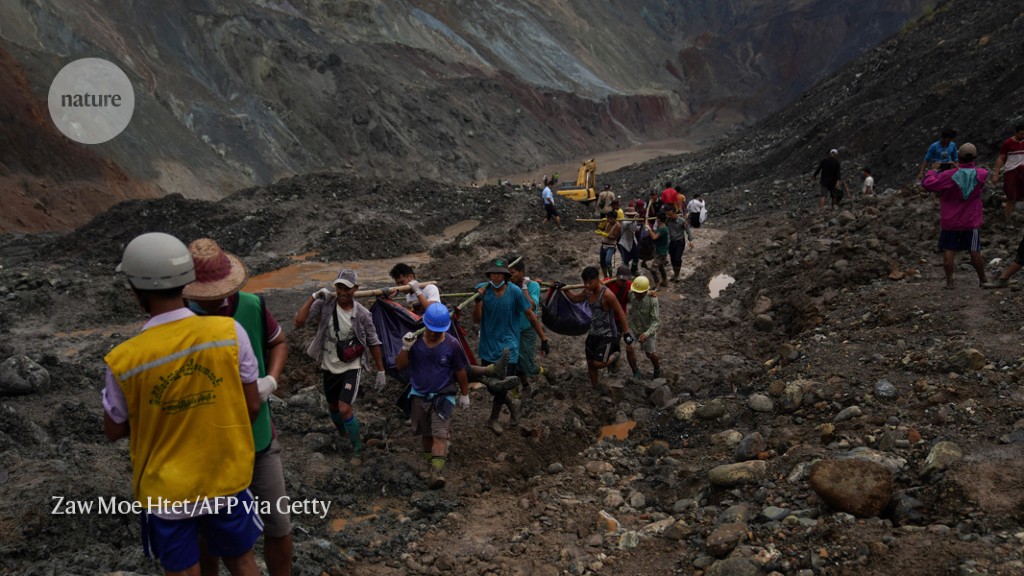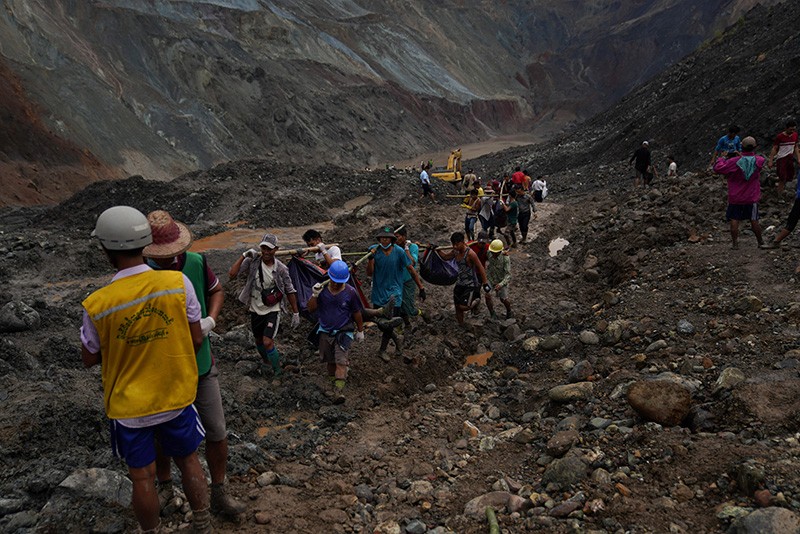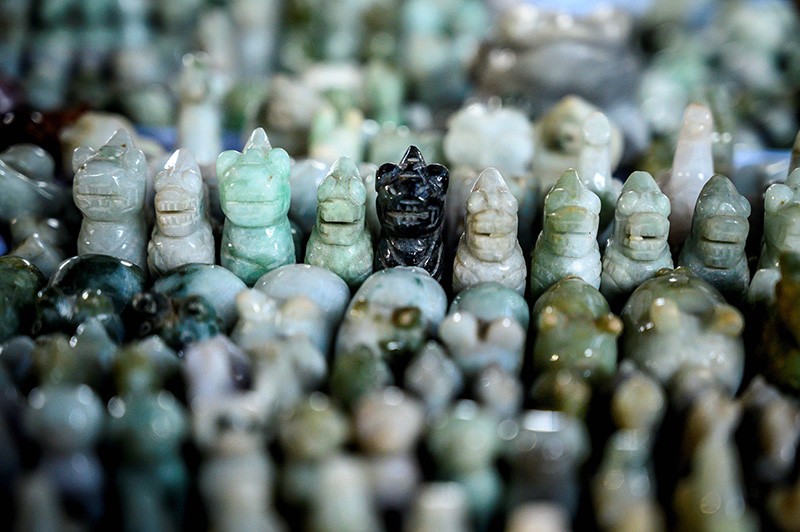A detailed analysis of satellite and remote-sensing data has uncovered poor conditions at the Wai Khar jade mine in northern Myanmar, where a landslide last July killed more than 170 people.
The international team of authors behind the study1 — the first to rigorously document a mining accident in Myanmar — say the results suggest that mismanagement and poor design contributed to the tragedy, not simply monsoon rains, as was initially assumed.
As well as shedding light on the causes of the disaster, which have not yet been fully resolved, the authors hope the findings will aid documentation of mine collapses and improve site planning — both in Myanmar and in other countries that see frequent mining accidents.
Mining of jade, largely for jewellery and carvings destined for China, has exploded in Myanmar in recent years. About 400,000 miners scavenge jade from the slopes of open-pit mines, often with little safety equipment. They feed an industry that supplies 90% of the world’s jade and earned an estimated US$8 billion in 2011 — 20% of the southeast Asian state’s export revenue.
Hundreds of deaths
The jade industry in Myanmar is poorly regulated and mine collapses are common, causing many hundreds of deaths since 2004, according to the study authors. But a lack of transparency from the Myanmar authorities — together with political and ethnic conflict in northern Kachin state, where jade mining is centred — means field surveys of mine sites are “nearly impossible”, the authors argue.
In what is thought to have been Myanmar’s worst mining disaster, in June last year rain began to saturate the ground at the northern section of the Wai Khar open-pit jade mine in the region of Hpakant. Eventually, on 2 July, a huge volume of quarry slope materials “collapsed into a flooded open pit, burying and killing at least 172 jade miners”, write the authors.
Although mining companies in Hpakant had been ordered by the authorities to suspend operations from 1 July for three months for the monsoon season, impoverished freelance scavengers were still hunting for unpicked jade exposed by rain. Heavy rainfall was initially assumed to be the trigger for the collapse.
Myanmar’s National Human Rights Commission blamed the landslide on the lack of due diligence and risk assessment from mining companies — at least 12 of which owned licences covering specific parts of the Wai Khar mine at the time of the accident. But non-governmental organizations say that a lack of regulatory oversight from the government in the mining industry is also a major problem endangering the lives of miners in Myanmar.
A spokesperson for Myanmar Gems Enterprise — the Myanmar government-owned regulator and issuer of mining licenses — told Nature that mining operations at the Wai Khar open-pit mine ended on 29 June before the accident, and that a government investigation concluded rainfall had infiltrated the ground via fractures in the rock, leading to the landslide. They added that the research findings will be valuable for assisting in future governance of the mining sector.
The mining companies either could not be reached for comment on the study, or did not respond to Nature’s queries on the causes of the disaster.
Given the lack of access to mine sites in Myanmar, a team of researchers from Taiwan, Singapore, Brazil and Thailand used data from remote sensing and satellites to investigate the collapse. These are often used to monitor mine sites in nations that have strict mining regulations. “There are a lot of things we can do from space,” says study co-author Wang Yu, a geologist at National Taiwan University in Taipei.
Aggressive mining cycles
To look for deformation in the landscape around the Wai Khar mine over time, Wang and his team combined online video footage of the accident from the ground with aerial and satellite data, as well as historical data from a NASA space-shuttle mission in 2000.
The authors found two factors that they think triggered the wall collapse, in addition to rainfall. Firstly, the walls of the mine were dangerously steep given the weak nature of the rock surrounding the pit. Google Earth images captured at intervals between 2013 and 2020 indicated periodic landslides had occurred in the pit, even where special steps had been dug out of the wall to prevent collapse, Wang says.
“The mining site is under aggressive mining cycles that are exacerbated by frequent, uncontrolled landslides,” he and his co-authors write. This process allows jade to be extracted more quickly, but creates dangerous conditions.
“The argument that the slope was too steep is very likely to be correct,” says Dave Petley, a geographer who studies landslides at the University of Sheffield, UK. He says he can’t be sure the landslide was associated with mining practices, but that operations should be designed to prevent deformation. “The authors show that the mine walls were actively deforming before failure,” he adds.
Poor mine design
Secondly, the study authors say that piles of mine waste acted like a sponge for rainfall or groundwater, and probably gradually leaked water that eroded the walls of the pit, aiding its collapse. The waste piles, detected in digital elevation data from NASA’s space shuttle in 2000 and Japan’s Advanced Land Observing Satellite from 2006–2011, shouldn’t have been so close to the mine, they say.
In an e-mail to Nature, the authors said that “there are issues of mismanagement and bad design in the pit”, but stop short of blaming anyone for the collapse. “Our analysis is only from the scientific viewpoint. It should be considered as an autopsy report, not a criminal complaint,” they said. “A thorough investigation will be needed in order to determine the correct share of responsibility among different parties.”
Kyi Htun, an independent mining geology consultant in Myanmar’s capital, Yangon, says that after reading the study, he thinks that poor site management — such as not monitoring how the slope changed over time and not disposing of waste properly — probably played a part in the accident. “No one has done mine design properly,” at the Wai Khar mine, he says.
Assisting other nations
San Htoi, a spokesperson for advocacy group Kachin Women’s Association Thailand, who visited the mine after the landslide, also says the findings are consistent with her observations: “The slope is too steep. It’s so dangerous.”
The authors of the study say they hope that the team’s work will encourage other scientists to perform similar analyses in nations where mining is poorly regulated. Between 2004 and 2016, mine accidents led to deaths in 32 countries, according to one report2.
As for the latest study, “It is a very comprehensive analysis of the mining accident,” says Birendra Bajracharya, coordinator of SERVIR-Hindu Kush Himalaya in Kathmandu, an international initiative that uses geospatial technologies to inform responses to environmental challenges. “The methodology will be useful to other researchers,” he adds.
Study co-author Yunung Nina Lin, a geologist at Academia Sinica in Taipei, says she hopes “the families of those who died can have a chance to learn about what had been happening on the mining site over the years”, and that “those in power can take the messages from this research and transform them into real actions.”








More News
Author Correction: Bitter taste receptor activation by cholesterol and an intracellular tastant – Nature
Audio long read: How does ChatGPT ‘think’? Psychology and neuroscience crack open AI large language models
Ozempic keeps wowing: trial data show benefits for kidney disease